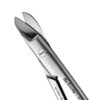Quiz 1 Flashcards
(69 cards)
What are the three main goals of operative dentistry?
- Diagnosis
- Prevention
- Treatment
What is the definition of tooth repair
- The mechanical alteration of a defective, injured or diseased tooth such that the placement of restorative material re-establishes normal form and function, including esthetic corrections were indicated
Name and describe the types of tooth preparation
-
Conventional preparations
- Precise procedures with specific depths, wall forms and marginal configurations
- Amalgams, cast metal and ceramic restorations
-
Modified preparations
- Less precise design requirements (simplified)
- Composite resins – materials properties and bonding strengths
What are the TYPES of LESIONS in restorative dentistry
name and describe
1. Caries = infectious disease
2. Abrasion = pathogenic wearing
3. Erosion = chemical dissolution
4. Attrition = physiologic wear
5. Fracture = trauma
6. Developmental defects = during birth
7. Abfraction = combined cause
What are the factors that affect tooth preparation
-
Diagnosis
- Pulpal and periodontal status will influence treatment options
- Occlusal evaluation
-
Dental Anatomy
- A mental image of the tooth being prepared/restored must be visualized
- Internal anatomy (enamel, dentin, pulp) must be considered
-
Patient Factors
- Medical status, economic status, age, esthetic concerns
-
Conservation of tooth structure
- Minimize pulpal insult, preserve healthy tooth structure
-
Restorative Material Considerations/factors
- Conventional vs. modified preparation
What are caries?
- Infectious, microbiologic disease that results in localized dissolution or destruction or calcified tissues of the teeth
- Episodic – demineralization and remineralization
What are primary caries
- Original carious lesion of a tooth
What are secondary caries?
- Occurs at the junction of a restoration and tooth…. Often progresses under the restoration
What are residual caries?
caries that remains in a completed preparation
What are incipient caries?
reversible, enamel surface is intact
What are cavitated caries?
irreversible, enamel surface is broken
What is nomenclature?
- A set of terms used in communication among individuals in the same profession, which enables them to understand one another better
What is armamentarium?
- A collection of resources available or utilized for an undertaking or field of activity; especially the equipment, methods, and pharmaceuticals used in medicine
What are hand instruments and their basic components?
- Designed to cut intraorally
- Left and right handed operators
- Temperature abuse of instruments will ruin them
- Basic elements of hand instruments:
- Handle (shaft) – to hold
- Blade – to cut
- Shank – to connect handle to the blade
What is the following instrument?
Name and Number

5 Mouth Mirror
What is the following instrument?
Name and Number

6 Straight Explorer
What is the following instrument?
Name and Number

23 Shepherds Hook Explorer
What is the following instrument?
Name and Number

Amalgam Carrier
What is the following instrument?
Name

Crown and Bridge Scissors
What is the following instrument?
Name

Hemostat
What is the following instrument?
Name and number

8/9 Hatchet
Used to plane proximal walls and gingival seats of class II cavity preparations
What is the following instrument?
Name

Marquette Pluggers
(Amalgam Condensers)
Used to pack or condense restorative material into a cavity preparation. The part equivalent to the blad is the nib. The end of the nib is the face
What is the following instrument?
Name

Ball burnisher / football burnisher
These are used to burnish restorative material (burnish is to smooth or polish by rubbing)
What is the following instrument?
Name

Acorn Burnisher
These are used to burnish restorative materials they may also be used in the carving process to aid in the development of anatomy





























